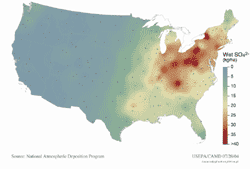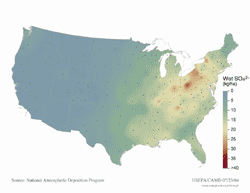|
 |
 |
Acid Rain Program 2003 Progress Report
|
Accelerating
Progress
The proposed Clean
Air Interstate Rule (CAIR)addresses power plant emissions in
29 eastern states plus the District of Columbia. CAIR would cut SO2
by more than 40 percent from today’s levels by 2010, and 70
percent when fully implemented. NOx emissions would be cut by 50
percent from today’s levels by 2010, and 60 percent when fully
implemented. The Agency plans to finalize CAIR this fall. |
|
|
You will need Adobe Acrobat Reader, available as a free download,
to view some of the files on this page. See EPA's
PDF page to learn more about PDF, and for a link to the free
Acrobat Reader.
|
Summary
Congress created the Acid Rain Program in Title IV of the 1990 Clean
Air Act Amendments. The Acid Rain Program has the goals of lowering the
electric power industry’s annual emissions of:
- Sulfur dioxide (SO2) to half of 1980 levels, capping them
at 8.95 million tons starting in 2010, and
- Nitrogen oxide (NOX) to 2 million tons lower than the forecasted
level for 2000, reducing annual emissions to a level of 6.1 million
tons in 2000.
In 2003, Acid Rain Program emission controls on the electric power industry
resulted in:
- SO2 emissions of 10.6 million tons, a reduction of 38
percent from 1980 levels. (See Figure 1) Emissions were 0.4 million tons higher
in 2003 than in 2002. This small increase resulted from increased production
of electricity by coal-fired and oil-fired units that emit much more
SO2 than natural gas units that generated less power in 2003.
The main cause of this was the substantial increase in natural gas prices.
Large, early SO2 reductions that were very beneficial at
the program’s outset enabled banked allowances to be available
to cover these emissions.
- NOX emissions of 4.2 million tons, which were close to
4 million tons less than the emissions forecasted for 2000 (See Figure
2). Other regulations, such as the NOX Budget Program in
the Northeast, also contributed to this reduction in emissions.
As in years past, the electric power industry achieved nearly 100 percent
compliance with Acid Rain Program requirements — only 1 unit had
emissions exceeding the SO2 allowances that it held and no
units were out of compliance with the NOX program. This exceptionally
high level of compliance was, in part, achieved as a result of the Acid
Rain Program’s continued provision of accurate and complete SO2
and NOX emissions data. This process was augmented by a substantial
auditing effort and accountability through rigorous, yet streamlined,
reporting systems.
SO2 and NOX are the key pollutants in the formation
of acid rain. These pollutants also contribute to the formation of fine
particles (sulfates and nitrates) that are associated with significant
health effects and regional haze. Additionally, NOX combines with volatile
organic compounds (VOCs) to form ozone (smog), and nitrates that are transported
and deposited at environmentally detrimental levels in parts of the country.
The United States (U.S.) electric power industry accounts for approximately
67 percent of total annual SO2 emissions and 22 percent of
total annual NOX emissions.
Since the Acid Rain Program began in 1995, the lower SO2 and
NOX emissions levels from the power sector have contributed
to significant air quality and environmental improvements that EPA’s
Clean Air Status and Trends Network (CASTNET) and other long-term environmental
monitoring networks are reporting.
Over the last decade:
- Ambient SO2 and sulfate levels are down more than 40 percent
and 30 percent, respectively, in the eastern U.S.
- Wet sulfate deposition, which acidifies sensitive lakes, streams and
forest soils, has decreased 39 percent in the northeastern U.S. and
17 percent in the southeastern U.S. (See Figure 3)
- Some modest reductions in inorganic nitrogen deposition and wet nitrate
concentrations have occurred in the Northeast and Mid-Atlantic regions,
but other areas have not shown much improvement.
- Signs of recovery in acidified lakes and streams are evident in the
Adirondacks, the northern Appalachian Plateau, and the upper Midwest.
These signs include lower concentrations of sulfates, nitrates, and
improvements in acid neutralizing capacity. Response of surface water
chemistry to the Clean Air Act Amendments of 1990.
Annual Mean Wet Sulfate Deposition
1989 through 1991

|
Annual Mean Wet Sulfate Deposition
2001 through 2003

|
|
Additional Information
The Clean Air Interstate
Rule
Response
of Surface Water Chemistry to the Clean Air Act Amendments of 1990
(PDF 92 pages, 4.6 MB)
Valuation
of Natural Resource Improvements in the Adirondacks 
(PDF 51 pages, 1.5 MB)
"Lessons from
Phase 2 Compliance with the U.S. Acid Rain Program" 
(PDF 23 pages, 390 KB)
“SO2
Control by Electric Utilities: What are the Gains from Trade?”

(PDF 37 pages, 166 KB)
Information
on Cap and Trade
Acid Rain Program
Acid Rain Reports from Prior Years
Data and Maps
|

